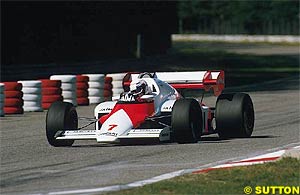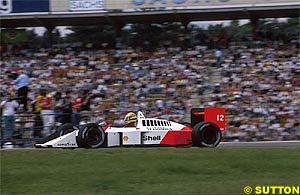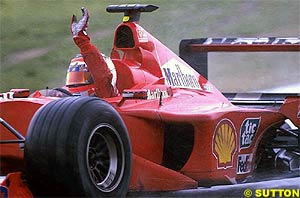
Atlas F1 Contributing Writer
After 25 Formula One Grands Prix running on the long straights among the woods, the Hockenheim circuit has been heavily revamped and the drivers will face a completely different challenge this weekend. Journalist and historian Doug Nye looks back at the history of the German circuit, the changes it underwent throughout the years, and the most memorable races it held
This was purely because - for the greater part of its length - it was blindingly, awesomely, fast! Now there's an odd travelling companion for circuits which are fast, circuits on which the awestruck spectator - you and I - can stand open mouthed as cars bullet into earshot throttle wide open, scream past one's vantage point throttle wide open, and echo away into the middle distance, still throttle wide open. That odd travelling companion is that almost universally such circuits are rubbished by the drivers for being 'boring'. Just occasionally, just once in a while, it makes you wish that some of those aces out there could spare the time to don waterproofs and Wellington boots, or sunhats and tee-shirts, and stand alongside us out in the boondocks, to see how Formula One looks from the paying side of the fence.
But then of course nasties began to occur. The higher the speed the greater the kinetic energy; the higher the speed, the heavier the impact. That cheerfully insouciant French driver Patrick Depailler died here in 1980, crashing his Alfa Romeo during a private Formula One test session. That darkly ambitious French driver Didier Pironi ended his career here in 1982, legs and feet shattered after an almighty practice session collision while 'flat-strap' in heavy rain and spray. The era of ground-effects cars was notorious for the diffuse fogball of atomised water which the underwing floor sections created in their wake. Hockenheim with its long straights on the forested back section tightly channelled and enclosed by dark, towering coniferous trees, tended to trap the fogball wakes and protect them from dissipation by whatever wind might be blowing. Flat-strap in his turbocharged Ferrari Pironi had arrowed over-confidently into just such a fogball - just such a 'fog wall' in fact - and had found it packed with very solid, unyielding, slower car. His accident had been the equivalent of the aeroplane pilot's nightmare - flying into a 'stuffed cloud', a cloud concealing a mountain.
Mercedes-Benz used the course for testing its 1939 Tripoli Grand Prix-winning W165 V8 Voiturette cars early in 1939 - it being easier to maintain secrecy there than at the longer, better known, Nurburgring. But the course had seen very little public use by the time World War 2 erupted, and it was only by dint of tremendous local enthusiasm and effort that it was revived in 1947 for German national racing. Hans Stuck - pre-war Auto Union and mountain-climb Champion - won in his 1100cc Cisitalia.
The 1948 meeting attracted the staggering attendance figure of 280,000 for the German population was even more starved of sporting spectacle and entertainment than anywhere else in austerity Europe. But money was always short and from 1951 to 1955 Hockenheim's race track lay virtually fallow. Then for 1955 the Rhein Cup sports car races were held there, and Mercedes-Benz used the course for testing their new Formula One and sports-racing cars. One driver who test-drove for them there and was immediately signed-up was Stirling Moss. The course was already blindingly fast - Karl Kling and Moss setting the record in Mercedes testing at over 128mph.
Meanwhile, the state authorities had laid plans for a new autobahn to Karlsruhe, and the line the surveyors drew on the map ran close to Hockenheim town, and sliced through the circuit site. The locals resisted the plans until State compensation levels had risen to such a level that the offer could not be refused, and there was sufficient funding to restore the circuit in revised and ultra-modern form. In the early 1960s work on the new autobahn finally began, and the original Hockenheimring which had seen occasional public race meetings held there, was closed for redevelopment in shortened form.
The result was a very fast slipstreaming course running out into the forest, before returning via the 180-degree Grosser Kurs to the new stadium section with its huge concrete grandstands. The new course instantly proved immensely unpopular for most drivers, but it hosted 500km sports car races, Formula Three internationals and eventually a series of Formula Two European Championship events before the German Grand Prix was moved there for 1970. The Jochen Rindt Memorial race followed, and Hockenheim then alternated with the Nurburgring North Circuit until 1976 when Lauda's fiery accident in the Eifel Mountains cooked Nurburg's goose and saw the German Grand Prix parked at Hockenheim until a new ersatz Nurburgring could be confected.
The German Grand Prix was, in fact, run on the 4.218-mile revised Hockenheimring course in 1970 and from 1977-81, while an Ostkurve chicane was introduced to slow cars through what had been the Grosser Kurs at the far extremity of the course in 1982, while the GP remained there to 1984, then returned 1986-89. The lap length became 4.227 miles with alterations to the Ostkurve chicane for the GPs of 1990-91, then 4.235 miles with an even tighter Ostkurve in 1992-93. A chicane in the middle of the return leg towards the stadium was tightened for 1994, when lap length became 4.240 miles and so the fiddling went on until this year, when the entire caboodle has been remodelled as you will see.
Hockenheim has undoubtedly seen some good racing. That first German GP held there in 1970 was a minor classic - a flat-out power battle between Jackie Ickx's flat-12 Ferrari 312B and Jochen Rindt's Lotus-Cosworth 72 - which the Austrian won. In 1971 Ickx won the non-Championship Rindt Memorial race there for Ferrari, from Ronnie Peterson's March and John Surtees's latest Surtees TS9. When the German GP returned there in 1977 it was Niki Lauda who won for Ferrari in the 312T2. Ronnie Peterson led the first five laps for Lotus in 1978, but it was team leader Mario Andretti who won in the 'ground effects' Lotus 79, with Ronnie completing a 'Black Magic' Lotus 1-2.
In 1983 Tambay led for Ferrari, but it was his French teammate Rene Arnoux who won for the Prancing Horse, from Andrea de Cesaris's Alfa Romeo. Hockenheim by this time had a rare reputation for sorting out the unreliable cars, and there were often few finishes in the German GP, and unusual names and marques picking-up handy World Championship points.
By 1984 we were into fuel economy turbocharged Formula One. The most efficient car/engine package in contention was the McLaren-TAG Turbo MP4/2, in which Alan Prost and Niki Lauda concluded a deadly dull 1-2 triumph for the Woking team. Michele Alboreto scored yet another Ferrari victory in this race in 1985, while in 1986 Nelson Piquet concluded a commanding victory for Williams-Honda despite two tyre stops. Virtually unheard of in those days. There were seven changes of lead that day.
The 1987 race should have been Alain Prost's 28th record-breaking Grand Prix victory - to elevate him above Jackie Stewart in the all-time stakes - but after seeing-off the Williams-Hondas on Porsche's home soil - Porsche being the manufacturers of McLaren's TAG Turbo V6 engine - his alternator drive belt snapped and the car ran out of sparks while leading with just four laps remaining. As he coasted to a silent, disconsolate halt beside the Ostkurve, Nelson Piquet won yet again for Williams-Honda, and Stefan Johansson limped his McLaren home in 2nd place on three inflated tyres.
Since then Hockenheim has seen the last win of Gerhard Berger's career - the first win of Rubens Barrichello's - the spectacular flash-fire engulfing Jos Verstappen's Benetton which blew the whistle on Tom Walkinshaw's brief honeymoon with the team - and McLaren-Mercedes-Benz's pit stop refuelling nozzle failures attributed by some within the team to sabotage by person or persons unknown. We have seen an aggrieved spectator almost halt the race by staging a one-man anti-Mercedes demonstration on track, and all the usual dramas, alarms and excursions which characterised Formula One for so long, staving off the boredom of which those drivers continued to complain.
But now the shortened, modified Hockenheimring is about to be served-up before us. Whether it will provide a feast or a flop we will soon know.
So this year's decided World Championship settles this weekend on the revamped Hockenheimring in Germany. For my generation of enthusiasts the Hockenheimring is the unloved, unwelcome replacement for the magnificent North Circuit of the Nurburgring. We didn't want it, we didn't like it, when the German Grand Prix was moved to this highly artificial course in 1970 while the Nurburgring was being modernised or - as we tended to see it at the time - emasculated. Hockenheim carried baggage with it. Unpleasant baggage. It was here on April 7, 1968, that the great double World Champion, Indy winner, Jimmy Clark had been killed while racing in a trifling little Formula Two race. And now the German Grand Prix had been moved onto this strange, flat, part flat-out, part Mickey Mouse stadium circuit. Whatever was the motor racing world coming to?
 In fact, as times and standards changed, so the Hockenheimring became regular home to the once mighty German Grand Prix. And as it became more familiar, and as old memories faded, so this curious design by committee - this oddball cross between a camel and a bulldozer - came to embody a kind of majestic presence and majesty all of its own.
In fact, as times and standards changed, so the Hockenheimring became regular home to the once mighty German Grand Prix. And as it became more familiar, and as old memories faded, so this curious design by committee - this oddball cross between a camel and a bulldozer - came to embody a kind of majestic presence and majesty all of its own.
 OK, so what brought the Hockenheimring into being? Although brand-spanking new in many respects this coming weekend, its origins are in fact just pre-Second World War. Motor sport was something of a national treasure in Nazi Germany and in 1939 the local authorities governing the small German town of Hockenheim, near Heidelberg, did their bit for mankind by improving and linking local roads to create the Hockenheimring in its original form. Hockenheim is some 14kms south-west of Heidelberg, 35kms north of Karlsruhe and was promoted as having 33 sizeable towns within a 60-mile radius, so it was thus in a handy catchment area to attract thousands of paying spectators to its planned motorcycle and motor race meetings. The original course was some 7.1kms to the lap - 4.8 miles - and it ran simply through dense woodland on level ground, with two long gently curving 'straights' linked by a fast curve at one end and by a slow hairpin adjacent to Hockenheim itself at the other.
OK, so what brought the Hockenheimring into being? Although brand-spanking new in many respects this coming weekend, its origins are in fact just pre-Second World War. Motor sport was something of a national treasure in Nazi Germany and in 1939 the local authorities governing the small German town of Hockenheim, near Heidelberg, did their bit for mankind by improving and linking local roads to create the Hockenheimring in its original form. Hockenheim is some 14kms south-west of Heidelberg, 35kms north of Karlsruhe and was promoted as having 33 sizeable towns within a 60-mile radius, so it was thus in a handy catchment area to attract thousands of paying spectators to its planned motorcycle and motor race meetings. The original course was some 7.1kms to the lap - 4.8 miles - and it ran simply through dense woodland on level ground, with two long gently curving 'straights' linked by a fast curve at one end and by a slow hairpin adjacent to Hockenheim itself at the other.
 Early in 1966 it was ready to reopen. The lap length of the revised course would come close to the original, at 4.2 miles - 6.768kms - but this was achieved by creating the wiggly stadium section at the lower end of the course adjacent to the new autobahn, under which the old southern section had disappeared. A short circuit within the stadium area would be used for minor race meetings, measuring 1.64-miles - 2.634kms - to the lap.
Early in 1966 it was ready to reopen. The lap length of the revised course would come close to the original, at 4.2 miles - 6.768kms - but this was achieved by creating the wiggly stadium section at the lower end of the course adjacent to the new autobahn, under which the old southern section had disappeared. A short circuit within the stadium area would be used for minor race meetings, measuring 1.64-miles - 2.634kms - to the lap.
 Alan Jones then scored his first victory for Williams here in 1979 in the FW07 - and teammate Clay Regazzoni made it a Williams 1-2. Jacques Laffite and Ligier triumphed in 1980, Reutemann and Jones 2-3 for Williams. An early Williams/Renault turbo battle evaporated in unreliability in the 1981 German GP - Nelson Piquet cruising by to win for Brabham despite a damaged skirt. The 1982 practice sessions then witnessed Pironi's horrifying accident, after which his teammate Patrick Tambay - himself a replacement for Gilles Villeneuve, killed in the Belgian GP qualifying sessions - picked-up Maranello's fortunes and won the race.
Alan Jones then scored his first victory for Williams here in 1979 in the FW07 - and teammate Clay Regazzoni made it a Williams 1-2. Jacques Laffite and Ligier triumphed in 1980, Reutemann and Jones 2-3 for Williams. An early Williams/Renault turbo battle evaporated in unreliability in the 1981 German GP - Nelson Piquet cruising by to win for Brabham despite a damaged skirt. The 1982 practice sessions then witnessed Pironi's horrifying accident, after which his teammate Patrick Tambay - himself a replacement for Gilles Villeneuve, killed in the Belgian GP qualifying sessions - picked-up Maranello's fortunes and won the race.
 It was Ayrton Senna's turn to win at Hockenheim in 1988 with the dominant McLaren-Honda MP4/4, with Prost 2nd in the sister car - of course - and in 1989 they repeated the treatment - 1-2, Senna/Prost - but this time in McLaren-Honda MP4/5s. Senna made it three German GPs in succession in the 1990 MP4/5B, but this time from Alessandro Nannini's Benetton-Ford. By 1991 it was all change as we entered what might be termed the modern era - Williams-Renaults uncatchable and Nigel Mansell leading home teammate Riccardo Patrese in a dominant Didcot 1-2.
It was Ayrton Senna's turn to win at Hockenheim in 1988 with the dominant McLaren-Honda MP4/4, with Prost 2nd in the sister car - of course - and in 1989 they repeated the treatment - 1-2, Senna/Prost - but this time in McLaren-Honda MP4/5s. Senna made it three German GPs in succession in the 1990 MP4/5B, but this time from Alessandro Nannini's Benetton-Ford. By 1991 it was all change as we entered what might be termed the modern era - Williams-Renaults uncatchable and Nigel Mansell leading home teammate Riccardo Patrese in a dominant Didcot 1-2.
Please Contact Us for permission to republish this or any other material from Atlas F1.
|
Volume 8, Issue 30
Articles
Never Say Nevers Again
Stepping into the Unknown
Ann Bradshaw: View from the Paddock
French GP Review
The 2002 French GP Review
July Champion
Job Security in France
German GP Preview
The 2002 German GP Preview
Local History: Germany
Stats Center
Qualifying Differentials
SuperStats
Charts Center
Columns
Season Strokes
Elsewhere in Racing
The Grapevine
> Homepage |